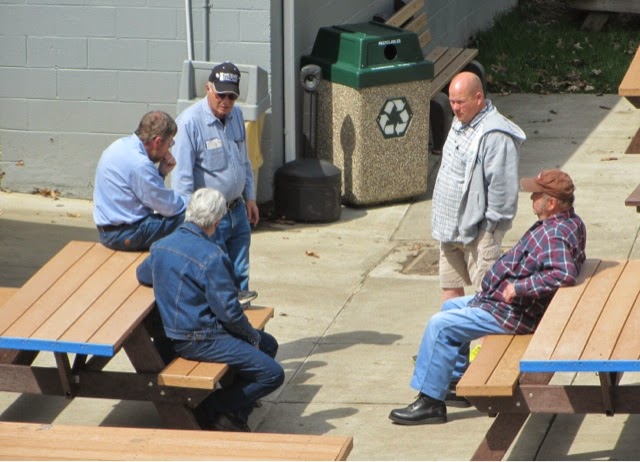Entrance to the Beckley Exhibition Mine, once a family-owned working coal mine. There were dozens of other mines throughout Raleigh County that produced 792,055,155 tons of bituminous coal in the first century of the county's coal industry, 1891-1991.
These are the two former coal miners that took us into the mine.
Each miner filled 10 to 12 carloads per day. Many miners brought their 10-12 year old sons into the mine to help them load the cars as they were paid only for what they brought out of the mine.
The coal vein was only 33 inches high so that's how tall the tunnel was. Get out a yardstick to see if you could stand up in the tunnel. Men crawled on their knees, duck walked, or used a scooter. Plus there was no light, the only light came from the lamp on the miner's hard hat.
This electric punching machine was used to undercut the coal vein to help expedite removal.
We made it safely out of the coal mine!
This coal town company store has been turned into a museum and gift shop.
Miner's scooter and water/lunch pail.
This is a kettle bottom, often called a "widowmaker" because these petrified tree stumps are smooth sided allowing them to slide loose from the coal and fall from the mine roof without warning. The miner who rode with us had a friend killed by a kettle bottom; when found kettle bottoms are bolted into place.
This is a chest auger used by miners to manually drill into the coal face and then the hole is filled with powder for blasting. In a low seam the miners often had to lie on their sides while drilling the long holes.
Guy talk...
Company House
This is a typical miner's three-room house with simple no frills construction. Known as "Jenny Linds" these structures date from between 1925 to the 1940s. Miners rented the house from the company and the rent was deducted from their paycheck. Often, to make ends meet, the family would rent out beds in their home to single miners.
Wash tubs
Kitchen
Living-room
Front porch light
Bedroom
Miner's Shanty
This one room dwelling dates to the early 1920s. It's a good example of getting by with the bare necessities. These homes were rented by single men or family men that returned home on the weekends. Their home away from home rented for $2.00 a month.
Community Church
Built in 1921, this Church is from the coal camp of Pemberton, West Virginia. Coal Baron Thomas Hurst Wickham paid to build the church and gave it as a gift to the community. It was the center of the coal camp community. The church's minister was also an integral part of the community. He married couples, preached to them on Sunday, visited them during the week, and even buried them. After Christmas services, the minister gave each person a gift of fruit and candy which came from the coal company. This is still an Appalachian tradition in some small country churches.
Community School
Each morning the children said the Pledge of Allegiance, sang The Star-Spangled Banner, and recited the Ten Commandments.
Dunce cap and stool in the front corner of the classroom. If you didn't behave, you might end up sitting here!
Teacher's desk and student desks. The younger students sat in front with older students in the back. This school has 2 rooms; one for first through fourth grades and another for 5th to 8th. Most students graduated from school at 8th grade. Many boys went to work in the coal mines.
Checker board table at the back of the classroom.
Scott looking for a book in the card catalog.
Well, most schools in Oregon don't hang a photograph of General Robert E. Lee on the wall!
New River Gorge National River
Sandstone Falls
Turkey Spur Overlook
Turkey's Spur got its name from the wild turkeys that used it for roosting within the gorge.
Scott hiked to the top of Turkey Spur. I spent my time visiting with a West Viriginia grandmother and granddaughter who were celebrating the grandma's 84th birthday. They had relatives up at the top! They come here often because it was their daughter/moms favorite spot and her ashes are scattered here.













































Isn't it interesting to find out how miners lived? Mining is no easy task, as there are a lot of dangers that come with that profession. But through this tour, we learn that miners have lives outside the mines, and that they were able to lead fulfilling lives as well. Thanks for sharng!
ReplyDeleteRosemary Bailey @ Wabi Iron & Steel Corp.